It is super exciting to see the rich set of features that Wi-Fi 6 has brought to the table. With the likes of high throughput, power optimization, and broadened security, Wi-Fi 6, as a technology that got enough to tempt the network upgrade. As a result, these promising capabilities could knock off an array of challenging access issues seen in the enterprise network.
In a typical enterprise setup, the network administrator is liable for leading the upgrade with no consequences. It warrants the admin to do due diligence in the planning phase to deal with the task smoothly.
Following are the top-of-the-mind questions of the administrator on the upgrade.
- Which areas need immediate access point upgrade
- What sort of Wi-Fi 6 Access points are the best fitting in the region
- When and how to migrate without network interruption
What, do they sound like inhibitors? How relieving it may be if there is an efficient tool that provides sufficient insights and guidance for successful upgrades? Here it is. We have the Cisco DNA Center at our disposal to accomplish the purpose. Cisco DNA Center has a wide range of features that help right from planning to execution stage of the upgrade tasks.
Planning phase
During the planning phase, the administrator determines the various regions facing different access issues and prioritizes accordingly. Following are some of the typical access issues
- The chokepoints in the access network in the form of excess congestion
- Areas that operate high power starving IoT devices
- Places where mobile devices struggle uplink performance
- Areas having higher interference, and so on.
Cisco DNA Center Assurance has an exclusive dashboard to give insights into the Wi-Fi 6 readiness of the enterprise network and a set of AI/ML-driven dashboards to detect the regions where the Wi-Fi 6 upgrade makes a difference. With Wi-Fi 6 dashboard, the administrator will get the pattern of which level of Wi-Fi 6 enabled clients are noticed in the network and the regions where they are spotted regularly. This dashboard additionally gives insights into what infra level upgrade is needed to enable Wi-Fi 6 in the network.
Once the network administrator obtains better information on the different regions for the network upgrade, the next logical step is to identify the appropriate types of Wi-Fi 6 access points to use. The good news is that Cisco offers a bundle of Wi-Fi 6 access points with all sorts of capabilities. Comparing and contrasting the various access points with the requirement will assist in finalizing the appropriate access points.
Upgrade phase
Usually, the network administrator will perform the upgrade activity during the planned maintenance window to prevent the loss of productivity of users. Cisco DNA Center offers a streamlined UI workflow byname “Access Point Refresh” using which the network administrator can conduct the upgrade task more fluidly.
Let us create a workflow task first
The preparatory work done in the planning phase will be handy. The workflow needs this information. Here is a quick digest of the steps involved in the workflow.
- At first, using this workflow, the network administrator should create a new upgrade task to capture the information as guided by the workflow. The administrator can edit and save the workflow task any number of times before submitting the replacement work to get triggered.
- In the workflow, the network administrator should select the site(s) and then the access points of those sites for replacement.
- Then the administrator must provide the serial ID of the replacing (new one) access points against each to-be-replaced (old one) access point. Cisco DNA Center uses this information to verify that the access point used for the replacement is genuine.
- There are two approaches to provide the new access point details. If the administrator has already connected the new AP to the corresponding switch, Cisco DNAC Center could detect that. As a result, the workflow shows this new AP that the administrator could select and proceed. Otherwise, if the new access point is not yet available to connect to the network or if the administrator plans that activity later, there will be a provision to add the serial ID manually. Cisco DNA Center learns the new AP through PNP or WLC discovery.
- There is also a CSV template to help the administrator capture the old and new access point information in case of bulk replacement.
Here is some screen captures to visualize the support.
It’s time to trigger the upgrade
Upon completion of the workflow, the administrator should submit the workflow to trigger the replacement activity. This offers many distinct approaches as follows for the admin to accomplish the task conveniently.
- The network admin starts with powering off and removing the old Access Point and afterward adding a new Access point in the same switch.
- On the other hand, if the new Access Point is not available yet, then the workflow task will wait till the new one gets connected to the network. The admin can follow the previous step when the new one is available.
As part of a successful replacement, the task copies all required config from the old Access Point to the new one and prepares it for serving the clients.
And finally, this workflow also provides the report with the status of the replacement. If any replacement tasks have failed for any interim reason, there is an option to retry the replacement task.
We hope Wi-Fi 6 is rather interesting and the enterprise can conveniently proceed with the upgrade task with Cisco DNA Center.
Learn more about Cisco Catalyst Access Points
Check out our Intent-Based Networking video channel.
Subscribe to the Networking blog

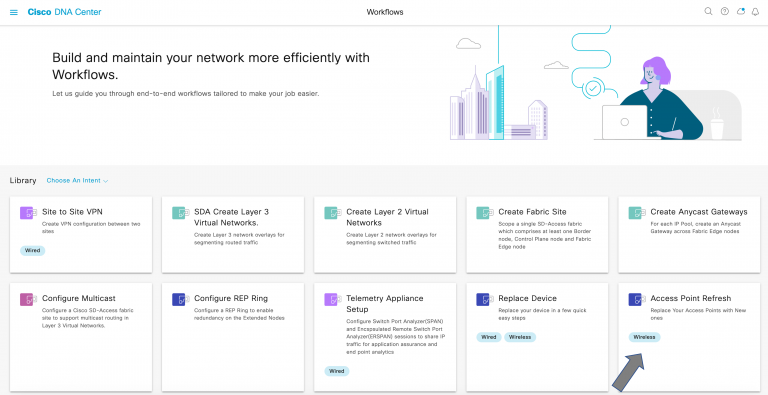

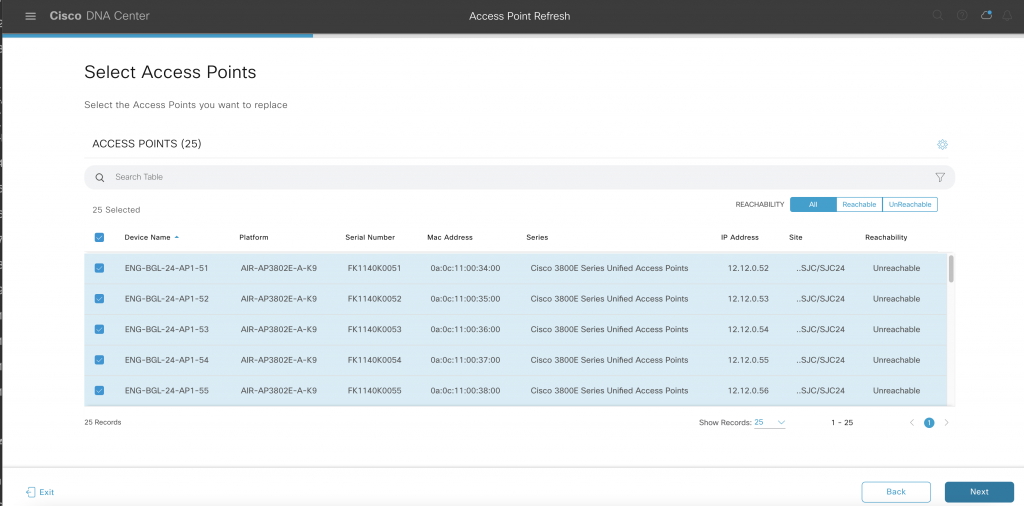

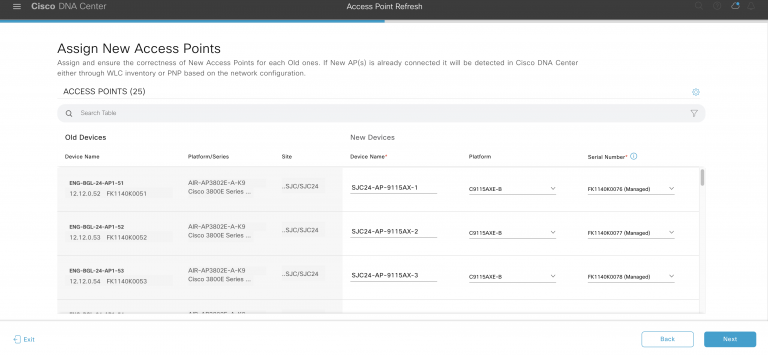
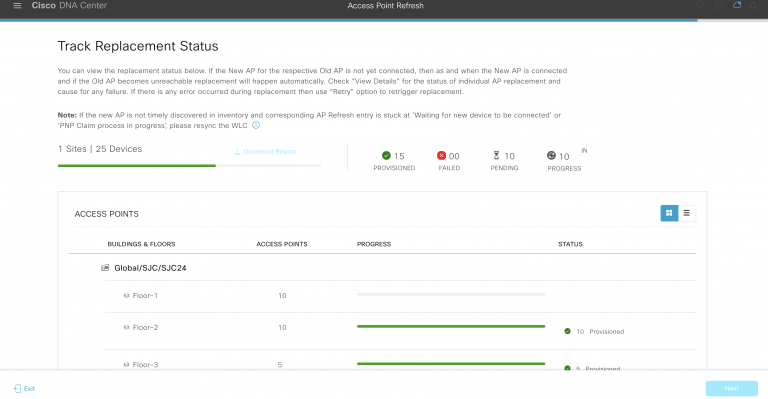
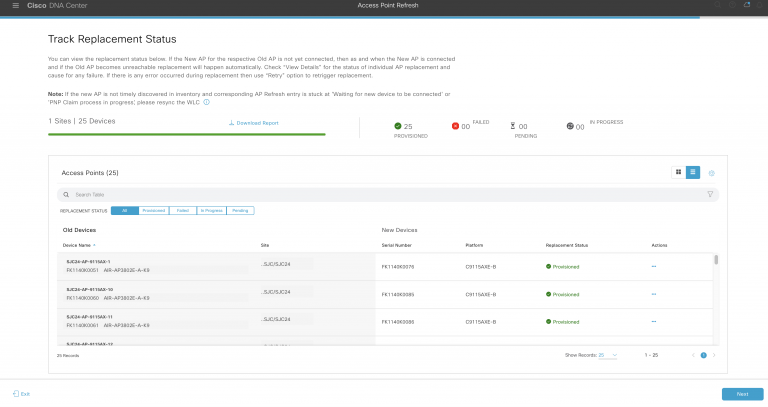


CONNECT WITH US